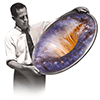Ah, the first day of “standard” time. What bizarre concept, daylight “savings” time. I wonder, how much time have I actually “saved,” and is there is a “time bank” where I can make a withdrawal the next time I need a few extra hours… ?
I don’t know if it was the time-shift or what but, unable to sleep even until dawn this morning, I fired up the laptop and did a bit of hypertext free-associating — otherwise known as “web-surfing” — and I spent a little time scrolling around in Tim Ventura’s “American Antigravity” site.
I see that in the past few days, Tim has posted a couple of articles about the Biefeld-Brown Effect. Talking about the B-B effect is slightly premature in terms of the narrative that I’m pasting together here, but I’m sure most readers are already aware that that’s where the story is going, so I don’t think I’m spoiling any surprises by bringing it up now.
The first article is a fairly rigorous and technically obtuse discussion of testing the B-B effect in a vacuum. These vacuum tests are often conducted and/or cited as a means of demonstrating and/or proving that the effect is a true “field effect,” and not attributable to something more akin to “ion wind” (which critics of the effect find a more palatable explanation).
The second paragraph of this article makes this statement: “The experiment uses a candle flame to measure the effects of EM forces (just like in the original B-B experiments).”
I gotta tell ya folks, I read stuff like that and it makes me feel like a complete idiot: I’ve been reading about Townsend Brown’s experiments for three years now, and nowhere can I recall anything about “original B-B experiments” that were conducted using a candle. Jeez, did I miss something? Wouldn’t be the first time. I’m going to have to write the author of this article, George White, and ask him what his source was on this assertion.
The second article on the AAG site is a short essay by Tim Ventura himself that provides some overview of the complexities of testing this effect and reporting the results. I found it curious that Tim sites one test conducted in a NASA vacuum chamber, saying that “Hector Serrano & Gravitec (Purdue spinoff) saw significant thrust in 2000.”
Hector reported on these experiments over at the fusor.net website, but my sense from reading Hector’s posts is that the the results were far less impressive than Tim Ventura’s choice of words implies. The best Hector describes is a barely “visible force” — of curiously undetermined origin.
On that much I guess we can all agree. As Tim says at the conclusion of his essay, “In the final analysis, the Biefeld-Brown Effect has remained a riddle for the last 40+ years, and will continue to haunt us as an unknown factor for at least several more…”
Amen, brother.
{note 221207: the URLs embedded above no longer link directly to the original americanantigravity.com website; they have all been redirected to Tim Ventura’s YouTube Channel. }


I can’t find the original reference I saw, but I have found something similar.
http://groups.physics.umn.edu/demo/electricity/5B3040.html
This demonstrates an ionic wind and directs the candle flame to the negative plate. In my experiment, the ionic wind component of this effect can be shielded with a mechanical barrier, like a glass envelope. An independent EM based effect can be shielded by enclosing the candle in a Faraday cage, like a rolled up piece of brass screen.
The EM effect is polarity independent and always pushesthe flame towards the larger plate. By using an AC stimulus, the ionic wind component can be made to almost go to zero, but the EM effect is still present.
-George